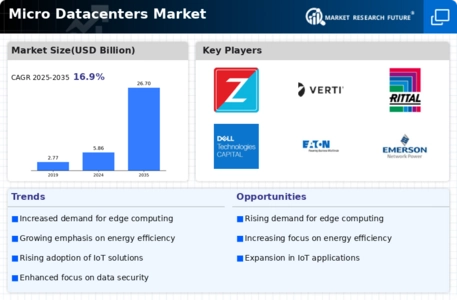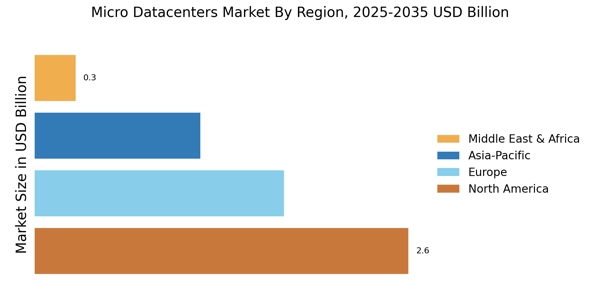Sustainability Initiatives
The Micro Datacenters Market is increasingly influenced by sustainability initiatives as organizations strive to reduce their carbon footprint. Micro datacenters are often designed with energy-efficient technologies and renewable energy sources, making them an appealing choice for environmentally conscious businesses. Recent studies indicate that energy consumption in data centers accounts for a significant portion of global electricity use, prompting a shift towards more sustainable solutions. The micro datacenters segment is expected to grow as companies implement strategies to meet sustainability goals, with projections suggesting a potential market growth of 18% in the next few years. This trend reflects a broader commitment to environmental responsibility and the adoption of green technologies within the Micro Datacenters Market.
Enhanced Security Requirements
In an era where data breaches and cyber threats are increasingly prevalent, the Micro Datacenters Market is responding to heightened security requirements. Organizations are prioritizing data protection and compliance with stringent regulations, which has led to a growing preference for micro datacenters. These facilities offer enhanced security features, including physical security measures and advanced encryption technologies. As businesses seek to safeguard sensitive information, the micro datacenters segment is expected to see a significant uptick in adoption. Recent data indicates that the market for secure micro datacenters could expand by over 15% annually, as companies invest in solutions that mitigate risks associated with data storage and processing. This trend underscores the critical role of micro datacenters in ensuring data integrity and security.
Rising Demand for Data Processing
The Micro Datacenters Market is experiencing a notable surge in demand for localized data processing capabilities. As organizations increasingly rely on real-time data analytics, the need for micro datacenters has become apparent. These facilities enable businesses to process data closer to the source, thereby reducing latency and enhancing operational efficiency. According to recent estimates, the micro datacenters segment is projected to grow at a compound annual growth rate of approximately 20% over the next five years. This growth is driven by the proliferation of IoT devices and the need for immediate data processing, which micro datacenters are uniquely positioned to address. Consequently, the Micro Datacenters Market is likely to witness substantial investments aimed at expanding infrastructure to meet this rising demand.
Advancements in Network Connectivity
The Micro Datacenters Market is benefiting from advancements in network connectivity, which are essential for the effective operation of micro datacenters. Enhanced connectivity solutions, such as 5G and fiber-optic networks, facilitate faster data transmission and improved communication between devices. As businesses increasingly rely on interconnected systems, the demand for micro datacenters that can leverage these technologies is likely to rise. Market forecasts indicate that the integration of advanced connectivity solutions could drive a growth rate of around 22% in the micro datacenters segment over the next few years. This trend highlights the importance of robust network infrastructure in supporting the evolving needs of the Micro Datacenters Market.
Shift Towards Decentralized Infrastructure
The Micro Datacenters Market is witnessing a paradigm shift towards decentralized infrastructure, driven by the need for flexibility and scalability. Traditional centralized data centers often struggle to meet the demands of modern applications, leading organizations to explore micro datacenters as a viable alternative. These smaller, modular facilities can be deployed rapidly and scaled according to specific needs, making them particularly attractive for businesses with fluctuating workloads. Market analysis suggests that the adoption of decentralized solutions could increase by approximately 25% in the coming years, as companies recognize the advantages of micro datacenters in enhancing operational agility. This shift not only optimizes resource utilization but also aligns with the growing trend of digital transformation across various sectors.

















Leave a Comment